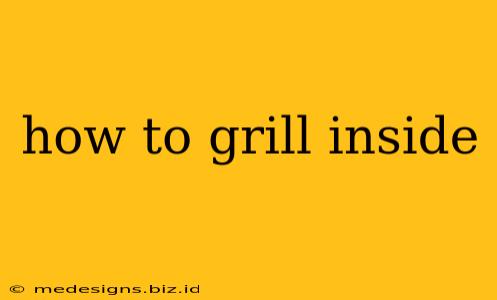Want the smoky, charred flavor of grilled food without the hassle of setting up an outdoor grill? Grilling indoors is easier than you think! This guide will walk you through the best methods and safety tips to achieve delicious results in the comfort of your own kitchen.
Choosing Your Indoor Grilling Method
Several methods allow for indoor grilling, each with its own advantages and disadvantages:
1. Indoor Electric Grills: Convenience and Control
Electric indoor grills are a fantastic option for beginners. They offer precise temperature control, easy cleanup, and are generally safer than other methods. Many models feature non-stick surfaces and removable plates for quick washing. Consider features like adjustable temperature settings, drip trays, and size before purchasing.
2. Grill Pan: Budget-Friendly and Versatile
A grill pan is a cost-effective way to achieve that distinctive grill mark aesthetic. Made from cast iron or non-stick materials, grill pans work on any stovetop. Remember to preheat your grill pan thoroughly for best results. While it won't deliver the same intense heat as an outdoor grill, it's a great option for smaller portions or when space is limited.
3. Stovetop Grilling Basket: Perfect for Smaller Foods
Stovetop grilling baskets are ideal for grilling smaller items like vegetables, shrimp, or fish. Their perforated design allows for even cooking and easy flipping. These baskets are also lightweight and easy to store.
4. Cast Iron Skillet: The Ultimate Grilling All-Rounder
A cast iron skillet provides exceptional heat retention and distribution, making it perfect for searing meats and creating those coveted grill marks. Its durability and versatility mean it can move from the stovetop to the oven with ease. Proper seasoning is key to maintaining a non-stick surface and preventing rust.
Safety First: Indoor Grilling Precautions
While grilling indoors offers convenience, it's crucial to prioritize safety:
- Ventilation: Always use your kitchen exhaust fan or open windows to vent out smoke and fumes. Never grill indoors without adequate ventilation.
- Fire Safety: Keep a fire extinguisher nearby, and be mindful of any flammable materials in the vicinity. Never leave your grill unattended.
- Heat Resistance: Use oven mitts and heat-resistant utensils to prevent burns.
- Cleaning: Clean your grill immediately after use to prevent grease fires.
Mastering the Art of Indoor Grilling: Tips and Tricks
- Preheat your grill: Whether it's an electric grill, grill pan, or cast iron skillet, preheating is vital for achieving good sear marks and even cooking.
- Oil your grill surface: This prevents sticking and helps create those characteristic grill marks. Use a high-smoke-point oil like canola or avocado oil.
- Don't overcrowd the grill: Leave space between food items to allow for even cooking and proper browning.
- Use tongs or a spatula: Avoid piercing the food, which can cause juices to escape.
- Check for doneness: Use a meat thermometer to ensure your food reaches the safe internal temperature.
Recipes for Indoor Grilling Success
The beauty of indoor grilling is its versatility. You can grill virtually anything you would outdoors! Try these ideas:
- Grilled Chicken Breast: Marinate your chicken for extra flavor before grilling.
- Grilled Salmon: Season with lemon, herbs, and a touch of salt and pepper.
- Grilled Vegetables: Bell peppers, zucchini, onions, and asparagus all grill beautifully indoors.
- Grilled Cheese Sandwich (Elevated!): Take your grilled cheese to the next level by using a grill pan for crispy, browned perfection.
Indoor grilling is a convenient and delicious alternative to outdoor grilling. By following these tips and prioritizing safety, you can enjoy the smoky goodness of grilled food all year round. Experiment with different methods and recipes to find your perfect indoor grilling setup!
